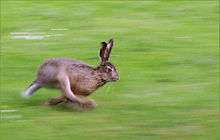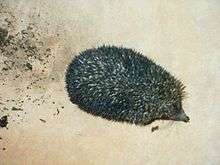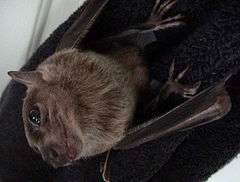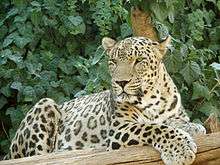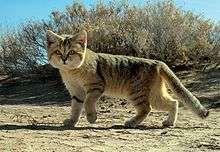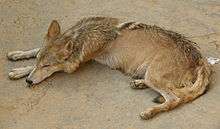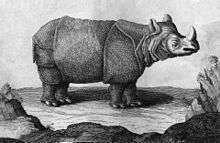List of mammals of Iran
This is a list of the mammal species recorded in Iran. There are 191+11 (Karami et al., 2008) mammal species in Iran, of which 2 are critically endangered, 6 are endangered, 17 are vulnerable, and 5 are near-threatened.[1]
The following tags are used to highlight each species' conservation status as assessed by the IUCN:
| EX | Extinct | No reasonable doubt that the last individual has died. |
| EW | Extinct in the wild | Known only to survive in captivity or as a naturalized populations well outside its previous range. |
| CR | Critically endangered | The species is in imminent risk of extinction in the wild. |
| EN | Endangered | The species is facing an extremely high risk of extinction in the wild. |
| VU | Vulnerable | The species is facing a high risk of extinction in the wild. |
| NT | Near threatened | The species does not meet any of the criteria that would categorise it as risking extinction but it is likely to do so in the future. |
| LC | Least concern | There are no current identifiable risks to the species. |
| DD | Data deficient | There is inadequate information to make an assessment of the risks to this species. |
Some species were assessed using an earlier set of criteria. Species assessed using this system have the following instead of near threatened and least concern categories:
| LR/cd | Lower risk/conservation dependent | Species which were the focus of conservation programmes and may have moved into a higher risk category if that programme was discontinued. |
| LR/nt | Lower risk/near threatened | Species which are close to being classified as vulnerable but are not the subject of conservation programmes. |
| LR/lc | Lower risk/least concern | Species for which there are no identifiable risks. |
Subclass: Theria
Infraclass: Eutheria
Order: Sirenia (manatees and dugongs)
Sirenia is an order of fully aquatic, herbivorous mammals that inhabit rivers, estuaries, coastal marine waters, swamps, and marine wetlands. All four species are endangered.
- Family: Dugongidae
Order: Rodentia (rodents)
Rodents make up the largest order of mammals, with over 40 percent of mammalian species. They have two incisors in the upper and lower jaw which grow continually and must be keep short by gnawing. Most rodents are small though the capybara can weigh up to 45 kg (100 lb).
- Suborder: Hystricomorpha
- Family: Hystricidae
- Genus: Hystrix
- Indian crested porcupine Hystrix indica
- Genus: Hystrix
- Family: Hystricidae
- Suborder: Sciurognathi
- Family: Sciuridae (squirrels)
- Subfamily: Sciurinae
- Tribe: Sciurini
- Genus: Sciurus
- Caucasian squirrel Sciurus anomalus LR/nt (pallescens ssp)
- Genus: Sciurus
- Tribe: Sciurini
- Subfamily: Callosciurinae
- Genus: Funambulus
- Northern palm squirrel Funambulus pennantii LR/lc
- Genus: Funambulus
- Subfamily: Xerinae
- Tribe: Xerini
- Genus: Spermophilopsis
- Long-clawed ground squirrel Spermophilopsis leptodactylus LR/lc
- Genus: Spermophilopsis
- Tribe: Marmotini
- Genus: Spermophilus
- Yellow ground squirrel Spermophilus fulvus LR/lc
- Genus: Spermophilus
- Tribe: Xerini
- Subfamily: Sciurinae
- Family: Castoridae
- Genus: Castor
- European beaver Castor fiber LR/lc
- Genus: Castor
- Family: Gliridae (dormice)
- Subfamily: Leithiinae
- Genus: Dryomys
- Forest dormouse Dryomys nitedula LR/nt
- Genus: Myomimus
- Masked mouse-tailed dormouse Myomimus personatus VU
- Setzer's mouse-tailed dormouse Myomimus setzeri EN
- Genus: Dryomys
- Subfamily: Glirinae
- Genus: Glis
- Edible dormouse Glis glis LR/nt
- Genus: Glis
- Subfamily: Leithiinae
- Family: Dipodidae (jerboas)
- Subfamily: Allactaginae
- Genus: Allactaga
- Small five-toed jerboa Allactaga elater LR/lc
- Euphrates jerboa Allactaga euphratica LR/nt
- Iranian jerboa Allactaga firouzi CR
- Hotson's jerboa Allactaga hotsoni LR/lc
- Williams' jerboa Allactaga williamsi LR/lc
- Genus: Pygeretmus
- Dwarf fat-tailed jerboa Pygeretmus pumilio LR/lc
- Genus: Allactaga
- Subfamily: Dipodinae
- Genus: Dipus
- Northern three-toed jerboa Dipus sagitta LR/lc
- Genus: Jaculus
- Blanford's jerboa Jaculus blanfordi LR/lc
- Lesser Egyptian jerboa Jaculus jaculus LC
- Genus: Dipus
- Subfamily: Allactaginae
- Family: Spalacidae
- Genus: Spalax
- Lesser mole rat Spalax leucodon lc
- Genus: Spalax
- Family: Calomyscidae
- Genus: Calomyscus
- Zagros Mountains mouse-like hamster Calomyscus bailwardi LR/lc
- Afghan mouse-like hamster Calomyscus mystax LR/nt
- Urar mouse-like hamster Calomyscus urartensis LR/nt
- Calomyscus elburzensis elborzensis Calomyscus LR/lc
- Genus: Calomyscus
- Family: Cricetidae
- Subfamily: Cricetinae
- Genus: Cricetulus
- Gray dwarf hamster Cricetulus migratorius LR/nt
- Genus: Mesocricetus
- Turkish hamster Mesocricetus brandti LR/lc
- Golden hamster Mesocricetus auratus LR/lc
- Genus: Cricetulus
- Subfamily: Arvicolinae
- Genus: Arvicola
- Water vole Arvicola terrestris LR/lc
- Genus: Blanfordimys
- Afghan vole Blanfordimys afghanus LR/lc
- Genus: Ellobius
- Northern mole vole Ellobius talpinus LR/lc
- Southern mole vole Ellobius fuscocapillus LR/lc
- Transcaucasian mole vole Ellobius lutescens LR/lc
- Genus: Microtus
- Günther's vole Microtus guentheri LR/nt
- Persian vole Microtus irani LR/lc
- Baluchistan vole Microtus kermanensis EN
- Altai vole Microtus obscurus LR/lc
- Social vole Microtus socialis LR/lc
- Transcaspian vole Microtus transcaspicus LR/lc
- European pine vole Microtus subterraneus LR/lc
- Common vole Microtus arvalis LR/lc
- Major's pine vole Microtus majori LR/lc
- Genus: Arvicola
- Subfamily: Cricetinae
- Family: Muridae (mice, rats, voles, gerbils, hamsters, etc.)
- Subfamily: Deomyinae
- Genus: Acomys
- Cairo spiny mouse Acomys cahirinus LC
- Genus: Acomys
- Subfamily: Gerbillinae
- Genus: Gerbillus
- Swarthy gerbil Gerbillus aquilus LR/lc
- Cheesman's gerbil Gerbillus cheesmani LR/lc
- Gerbillus mesopotamiae LR/lc
- Gerbillus nanus LC
- Genus: Meriones
- Sundevall's jird Meriones crassus LC
- Indian desert jird Meriones hurrianae LR/lc
- Libyan jird Meriones libycus LC
- Mid-day jird Meriones meridianus LR/lc
- Persian jird Meriones persicus LR/lc
- Tristram's jird Meriones tristrami LR/lc
- Vinogradov's jird Meriones vinogradovi LR/lc
- Zarudny's jird Meriones zarudnyi EN
- Genus: Rhombomys
- Great gerbil Rhombomys opimus LR/lc
- Genus: Tatera
- Indian gerbil Tatera indica LR/lc
- Genus: Gerbillus
- Subfamily: Murinae
- Genus: Apodemus
- Persian field mouse Apodemus arianus LR/lc
- Yellow-breasted field mouse Apodemus fulvipectus LR/lc
- Broad-toothed field mouse Apodemus mystacinus LR/lc
- Black Sea field mouse Apodemus ponticus LR/lc
- Ward's field mouse Apodemus wardi LR/lc
- Genus: Golunda
- Indian bush rat Golunda ellioti LR/lc
- Genus: Mus
- Macedonian mouse Mus macedonicus LR/lc
- Genus: Nesokia
- Short-tailed bandicoot rat Nesokia indica LC
- Genus: Rattus
- Turkestan rat Rattus turkestanicus LR/lc
- Black rat Rattus ratus LR/lc - Probably Introduced
- Brown rat Rattus norvegicus LR/lc - Probably Introduced
- Genus: Apodemus
- Subfamily: Deomyinae
- Family: Sciuridae (squirrels)
Order: Lagomorpha (lagomorphs)
The lagomorphs comprise two families, Leporidae (hares and rabbits), and Ochotonidae (pikas). Though they can resemble rodents, and were classified as a superfamily in that order until the early 20th century, they have since been considered a separate order. They differ from rodents in a number of physical characteristics, such as having four incisors in the upper jaw rather than two.
- Family: Ochotonidae (pikas)
- Genus: Ochotona
- Afghan pika Ochotona rufescens LR/lc
- Genus: Ochotona
- Family: Leporidae (rabbits, hares)
- Genus: Lepus
- European hare Lepus europaeus LR/lc
- Cape hare Lepus capensis LR/lc
- Genus: Lepus
Order: Erinaceomorpha (hedgehogs and gymnures)
The order Erinaceomorpha contains a single family, Erinaceidae, which comprise the hedgehogs and gymnures. The hedgehogs are easily recognised by their spines while gymnures look more like large rats.
- Family: Erinaceidae (hedgehogs)
- Subfamily: Erinaceinae
- Genus: Erinaceus
- Southern white-breasted hedgehog Erinaceus concolor LR/lc
- Genus: Hemiechinus
- Long-eared hedgehog Hemiechinus auritus LR/lc
- Brandt's hedgehog Hemiechinus hypomelas LR/lc
- Genus: Erinaceus
- Subfamily: Erinaceinae
Order: Soricomorpha (shrews, moles, and solenodons)
The "shrew-forms" are insectivorous mammals. The shrews and solenodons closely resemble mice while the moles are stout-bodied burrowers.
- Family: Soricidae (shrews)
- Subfamily: Crocidurinae
- Genus: Crocidura
- Gmelin's white-toothed shrew Crocidura gmelini LR/lc
- Bicolored shrew Crocidura leucodon LR/lc
- Lesser white-toothed shrew Crocidura suaveolens LR/lc
- Iranian shrew Crocidura susiana EN
- Zarudny's shrew Crocidura zarudnyi LR/lc
- Genus: Crocidura
- Subfamily: Soricinae
- Tribe: Nectogalini
- Genus: Neomys
- Transcaucasian water shrew Neomys schelkovnikovi LR/lc
- Genus: Neomys
- Tribe: Soricini
- Genus: Sorex
- Caucasian pygmy shrew Sorex volnuchini LR/lc
- Genus: Sorex
- Tribe: Nectogalini
- Subfamily: Crocidurinae
- Family: Talpidae (moles)
- Subfamily: Talpinae
- Tribe: Talpini
- Genus: Talpa
- Père David's mole Talpa streeti CR
- Genus: Talpa
- Tribe: Talpini
- Subfamily: Talpinae
Order: Chiroptera (bats)
The bats' most distinguishing feature is that their forelimbs are developed as wings, making them the only mammals in the world naturally capable of flight. Bat species account for about 20% of all mammals.
- Family: Pteropodidae (flying foxes, Old World fruit bats)
- Subfamily: Pteropodinae
- Genus: Rousettus
- Egyptian fruit bat Rousettus aegyptiacus LC
- Genus: Rousettus
- Subfamily: Pteropodinae
- Family: Vespertilionidae
- Subfamily: Myotinae
- Genus: Myotis
- Bechstein's bat Myotis bechsteini VU
- Lesser mouse-eared bat Myotis blythii LR/lc
- Long-fingered bat Myotis capaccinii VU
- Geoffroy's bat Myotis emarginatus VU
- Whiskered bat Myotis mystacinus LR/lc
- Natterer's bat Myotis nattereri LR/lc
- Schaub's myotis Myotis schaubi EN
- Genus: Myotis
- Subfamily: Vespertilioninae
- Genus: Barbastella
- Eastern barbastelle Barbastella leucomelas LR/lc
- Genus: Eptesicus
- Bobrinski's serotine Eptesicus bobrinskoi LR/lc
- Botta's serotine Eptesicus bottae LC
- Sind bat Eptesicus nasutus VU
- Northern bat Eptesicus nilssoni LR/lc
- Serotine bat Eptesicus serotinus LR/lc
- Genus: Hypsugo
- Savi's pipistrelle Hypsugo savii LR/lc
- Genus: Nyctalus
- Greater noctule bat Nyctalus lasiopterus LR/nt
- Lesser noctule Nyctalus leisleri LR/nt
- Common noctule Nyctalus noctula LR/lc
- Genus: Pipistrellus
- Kuhl's pipistrelle Pipistrellus kuhlii LC
- Common pipistrelle Pipistrellus pipistrellus LC
- Genus: Plecotus
- Brown long-eared bat Plecotus auritus LR/lc
- Grey long-eared bat Plecotus austriacus LR/lc
- Genus: Vespertilio
- Parti-coloured bat Vespertilio murinus LR/lc
- Genus: Barbastella
- Subfamily: Miniopterinae
- Genus: Miniopterus
- Schreibers' long-fingered bat Miniopterus schreibersii LC
- Genus: Miniopterus
- Subfamily: Myotinae
- Family: Rhinopomatidae
- Genus: Rhinopoma
- Lesser mouse-tailed bat Rhinopoma hardwickei LC
- Greater mouse-tailed bat Rhinopoma microphyllum LC
- Small mouse-tailed bat Rhinopoma muscatellum LR/lc
- Genus: Rhinopoma
- Family: Emballonuridae
- Genus: Taphozous
- Egyptian tomb bat Taphozous perforatus LC
- Genus: Taphozous
- Family: Rhinolophidae
- Subfamily: Rhinolophinae
- Genus: Rhinolophus
- Blasius's horseshoe bat Rhinolophus blasii NT
- Bokhara horseshoe bat Rhinolophus bocharicus LR/lc
- Mediterranean horseshoe bat Rhinolophus euryale VU
- Greater horseshoe bat Rhinolophus ferrumequinum LR/nt
- Lesser horseshoe bat Rhinolophus hipposideros LC
- Mehely's horseshoe bat Rhinolophus mehelyi VU
- Genus: Rhinolophus
- Subfamily: Hipposiderinae
- Genus: Asellia
- Trident leaf-nosed bat Asellia tridens LC
- Genus: Triaenops
- Persian trident bat Triaenops persicus LC
- Genus: Asellia
- Subfamily: Rhinolophinae
Order: Cetacea (whales)

The order Cetacea includes whales, dolphins and porpoises. They are the mammals most fully adapted to aquatic life with a spindle-shaped nearly hairless body, protected by a thick layer of blubber, and forelimbs and tail modified to provide propulsion underwater.
More than 14 species have been recorded within the Iran's EEZ.[2]
- Suborder: Mysticeti
- Family: Balaenopteridae
- Subfamily: Balaenopterinae
- Genus: Balaenoptera
- Blue whale, Balaenoptera musculus EN
- Fin whale Balaenoptera physalus EN
- Sei whale Balaenoptera borealis EN
- Bryde's whale Balaenoptera edeni DD
- Omura's whale Balaenoptera omurai DD[3]
- Genus: Balaenoptera
- Subfamily: Megapterinae
- Genus: Megaptera
- Humpback whale Megaptera novaeangliae CR (Arabian Sea population)[4]
- Genus: Megaptera
- Subfamily: Balaenopterinae
- Family: Balaenopteridae
- Suborder: Odontoceti
- Superfamily: Platanistoidea
- Family: Phocoenidae
- Genus: Neophocaena
- Finless porpoise Neophocaena phocaenoides DD
- Genus: Neophocaena
- Family: Delphinidae (marine dolphins)
- Genus: Sousa
- Genus: Steno
- Rough-toothed dolphin Steno bredanensis DD
- Genus: Tursiops
- Bottlenose dolphin Tursiops aduncus DD
- Genus: Stenella
- Spinner dolphin Stenella longirostris DD
- Genus: Delphinus
- Long-beaked common dolphin Delphinus capensis LR/lc
- Genus: Lagenodelphis
- Fraser's dolphin Lagenodelphis hosei DD
- Genus: Grampus
- Risso's dolphin Grampus griseus DD
- Genus: Feresa
- Pygmy killer whale Feresa attenuata DD
- Genus: Peponocephala
- Melon-headed whale Peponocephala electra DD
- Genus: Pseudorca
- False killer whale Pseudorca crassidens DD
- Family: Phocoenidae
- Superfamily: Platanistoidea
Order: Carnivora (carnivorans)
There are over 260 species of carnivorans, the majority of which feed primarily on meat. They have a characteristic skull shape and dentition.
- Suborder: Feliformia
- Family: Felidae (cats)
- Subfamily: Felinae
- Genus: Acinonyx
- Asiatic cheetah Acinonyx jubatus venaticus CR
- Genus: Caracal
- Asiatic caracal Caracal caracal schmitzi LC
- Genus: Felis
- Common jungle cat Felis chaus chaus LC
- Turkestan sand cat Felis margarita thinobia NT
- Turkestan wildcat Felis silvestris caudata LC
- Syrian wildcat Felis silvestris nesterovi LC
- Pallas's cat Felis manul NT
- Genus: Lynx
- Caucasian lynx Lynx lynx dinniki VU
- Genus: Acinonyx
- Subfamily: Pantherinae
- Genus: Panthera
- Asiatic lion Panthera leo persica EN - extirpated 20th century
- Persian leopard Panthera pardus saxicolor EN
- Caspian tiger Panthera tigris virgata EX - extirpated around the 1950s
- Genus: Panthera
- Subfamily: Felinae
- Family: Procyonidae
- Family: Herpestidae (mongooses)
- Genus: Herpestes
- Indian gray mongoose Herpestes edwardsii LR/lc
- Genus: Herpestes
- Family: Hyaenidae (hyaenas)
- Genus: Hyaena
- Striped hyena Hyaena hyaena LR/nt
- Genus: Hyaena
- Family: Felidae (cats)
- Suborder: Caniformia
- Family: Canidae (dogs, foxes)
- Genus: Vulpes
- Blanford's fox Vulpes cana VU
- Corsac fox Vulpes corsac LC
- Rueppell's fox Vulpes rueppelli DD
- Red fox Vulpes vulpes LC
- Genus: Canis
- Common jackal Canis aureus aureus LC
- Indian wolf Canis lupus pallipes EN
- Genus: Vulpes
- Family: Ursidae (bears)
- Genus: Ursus
- Syrian brown bear Ursus arctos syriacus LR/lc
- Asiatic black bear Ursus thibetanus VU
- Genus: Ursus
- Family: Mustelidae (mustelids)
- Genus: Mustela
- Least weasel Mustela nivalis LR/lc
- Genus: Vormela
- Marbled polecat Vormela peregusna LR/lc
- Genus: Martes
- Beech marten Martes foina LR/lc
- Pine marten Martes martes LR/lc
- Genus: Mellivora
- Ratel Mellivora capensis LR/lc
- Genus: Meles
- Eurasian badger Meles meles LR/lc
- Genus: Lutra
- European otter Lutra lutra NT
- Genus: Mustela
- Family: Phocidae (earless seals)
- Genus: Pusa
- Caspian seal Pusa caspica VU
- Genus: Pusa
- Family: Canidae (dogs, foxes)
Order: Perissodactyla (odd-toed ungulates)
The odd-toed ungulates are browsing and grazing mammals. They are usually large to very large, and have relatively simple stomachs and a large middle toe.
- Family: Equidae (horses etc.)
- Genus: Equus
- Persian onager Equus hemionus onager EN
- Genus: Equus
- Family: Rhinocerotidae
- Genus: Rhinoceros
- Indian rhinoceros Rhinoceros unicornis VU - Implied existence in Iran.
- Genus: Rhinoceros
Order: Artiodactyla (even-toed ungulates)
The even-toed ungulates are ungulates whose weight is borne about equally by the third and fourth toes, rather than mostly or entirely by the third as in perissodactyls. There are about 220 artiodactyl species, including many that are of great economic importance to humans.
- Family: Suidae (pigs)
- Family: Cervidae (deer)
- Subfamily: Cervinae
- Genus: Cervus
- Red deer Cervus elaphus LR/lc
- Genus: Dama
- Fallow deer Dama dama LR/lc
- Genus: Cervus
- Subfamily: Cervinae
- Family: Bovidae (cattle, antelope, sheep, goats)
- Subfamily: Antilopinae
- Genus: Gazella
- Chinkara Gazella bennettii LC
- Goitered gazelle Gazella subgutturosa VU
- Mountain gazelle Gazella gazella VU
- Dorcas gazelle Gazella dorcas VU
- Genus: Gazella
- Subfamily: Caprinae
- Subfamily: Antilopinae
See also
- List of chordate orders
- List of regional mammals lists
- List of prehistoric mammals
- Mammal classification
- New mammal species
- Wildlife of Iran
Notes
- ↑ This list is derived from the IUCN Red List which lists species of mammals and includes those mammals that have recently been classified as extinct (since 1500 AD). The taxonomy and naming of the individual species is based on those used in existing Wikipedia articles as of 21 May 2007 and supplemented by the common names and taxonomy from the IUCN, Smithsonian Institution, or University of Michigan where no Wikipedia article was available.
- ↑ https://www.cbd.int/doc/meetings/mar/ebsaws-2015-02/other/ebsaws-2015-02-gobi-submission5-en.pdf
- ↑ Sharif Ranjbar S., Dakhteh S.M., Waerebeek V.K. (2016). "Omura's whale (Balaenoptera omurai ) stranding on Qeshm Island, Iran: further evidence for a wide (sub)tropical distribution, including the Persian Gulf" (pdf): 1–9. Retrieved 2016-04-18.
- ↑ New Arabian Humpback Whale Species Located in Oman
References
- "The IUCN Red List of Threatened Species: Mammals of Iran". IUCN. 2001. Retrieved 22 May 2007.
- "Mammal Species of the World". Smithsonian National Museum of Natural History. 2005. Archived from the original on 27 April 2007. Retrieved 22 May 2007.
- "Animal Diversity Web". University of Michigan Museum of Zoology. 1995–2006. Retrieved 22 May 2007.
- Current status of rodents of Iran Iran rodents (Persian)

